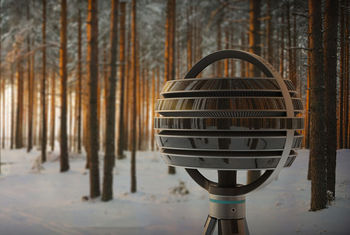Lytro Immerge: Difference between revisions
RealEditor (talk | contribs) phrasing |
RealEditor (talk | contribs) →Features: Remove commercial fluff |
||
| Line 40: | Line 40: | ||
}} | }} | ||
[[Lytro Immerge]] is a [[light field]] [[Cameras#Virtual Reality Cameras|VR video camera]] from Lytro, the company behind the Lytro ILLUM and the Original Lytro Light Field Camera. This camera is the first device in the world that is able to capture the full light field volume and give users six [[degrees of freedom]] (6DoF). Lytro Immerge comes with a dedicated server that is used to store and process all data captured by the camera and also a set of light field editing tools that integrate with all industry-standard video editors. Lytro wants to give immersive storytellers all the tools they might need to break away from the limitations of standard video experiences. First prototypes should be available to content creators in Q1 2016. | [[Lytro Immerge]] is a [[light field]] [[Cameras#Virtual Reality Cameras|VR video camera]] from Lytro, the company behind the Lytro ILLUM and the Original Lytro Light Field Camera. This camera is the first device in the world that is able to capture the full light field volume and give users six [[degrees of freedom]] (6DoF). Lytro Immerge comes with a dedicated server that is used to store and process all data captured by the camera and also a set of light field editing tools that integrate with all industry-standard video editors. Lytro wants to give immersive storytellers all the tools they might need to break away from the limitations of standard video experiences. First prototypes should be available to content creators in Q1 2016. | ||
==Hardware== | ==Hardware== | ||
Latest revision as of 19:06, 2 July 2025
| Lytro Immerge | |
|---|---|

| |
| Basic Info | |
| Type | Camera |
| Subtype | Virtual Reality Camera |
| Developer | Lytro |
| Release Date | Q1 2016 |
| Website | lytro immerge |
| System | |
| Storage | |
| Display | |
| Image | |
| Optics | |
| Tracking | |
| Audio | |
| Connectivity | |
| Device | |
Lytro Immerge is a light field VR video camera from Lytro, the company behind the Lytro ILLUM and the Original Lytro Light Field Camera. This camera is the first device in the world that is able to capture the full light field volume and give users six degrees of freedom (6DoF). Lytro Immerge comes with a dedicated server that is used to store and process all data captured by the camera and also a set of light field editing tools that integrate with all industry-standard video editors. Lytro wants to give immersive storytellers all the tools they might need to break away from the limitations of standard video experiences. First prototypes should be available to content creators in Q1 2016.
Hardware
Lytro Immerge includes a configurable, dense light field camera array with professional cinematic video quality and a dedicated server for storage and processing of light field data with ultra-high bandwidth direct-to-disk capture ability. Each server should be able to hold approximately an hour of 360-degree light-field video footage. For the first time in history, a camera is able to capture the full light field volume and thus give consumers six degrees of freedom experience. A total of five layers full of 360-degree cameras and sensors allow for accurate horizontal and vertical parallax, which is needed for realistic incorporation of CGI elements in the video. Each layer has approximately three to four times the data and resolution of any existing VR camera. According to Lytro, this could translate to up to 2k per eye in VR headsets.
Specifications
Software
The goal of this system is to introduce a new range of immersive storytelling experiences. To accomplish this goal, Lytro has developed a set of light field plugins for standard visual effect tools like Nuke, Final Cut Pro, Adobe Premiere, and Avid Media Composer that allow creators to seamlessly blend computer graphics and live action footage into one cohesive piece. These creations can be viewed on common virtual reality headsets and platforms thanks to dedicated light field video playback engine from Lytro.

